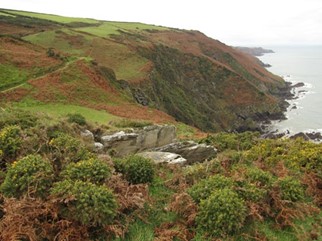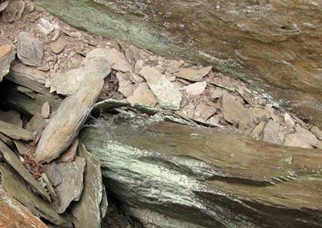Lithocalla ecorticata (J. R. Laundon) Orange comb. nov.
MycoBank number: MB 836550; Index Fungorum number: IF 836550; Facesoffungi number: FoF;
Lecanora ecorticata J. R. Laundon, Nova Hedwigia 76, 100–102 (2003).—Lepraria ecorticata (J. R. Laundon) Kukwa, Mycotaxon 97, 64 (2006); type: Great Britain, England, Devon (Vice- County (V.C.) 4), Ilfracombe, Torrs Walks, 21/50.47, on shaded vertical rocks, 1 September 1971, J. R. Laundon 2851 (BM—holotype [lost]) [Thin-layer chromatography: atranorin, usnic acid and zeorin, according to the protologue]; Wales, V.C. 49, Caernarvonshire, Beddgelert, Bethania, 2.25 miles south of Snowdon, SH626.509, abundant on underhang of wall running alongside a rough track, 30 April 1983, R. O. Millar (BM – 000763146—lectotype, designated here! MBT 393476) [Thin-layer chromatography: usnic acid, some terpenoids (in traces), 2005, Martin Kukwa].(Figs 3 & 4)
Prothallus absent or occasionally sparsely present in shade. Thallus crustose, diffuse, often forming large colonies, arising from aggregations of separate granules to form a leprose crust, pale yellow-green (Munsell 5GY 7–8/2), becoming blue-grey in deep shade; thallus eventually up to 2 mm thick, but then most of the thickness is of dead decolourized granules; thicker thalli may become cracked; granules fine, 60–100 μm diam., ecorticate, without projecting hyphae. Medulla and hypothallus absent. Ascomata and conidiomata unknown.
Chemistry. Unidentified terpenoid A at Rf class 6 in solvent system G, dirty grey-brown after heating, UV+ dull pink (minor), additional trace of a terpenoid at Rf class 6, immediately below usnic acid; two fatty acids, Rf class 4–5 in G (major or minor), appearing as a single spot Rf class 6 in solvent system A, traces of additional fatty acids; usnic acid (major); atranorin (accessory, minor). Zeorin is absent. Thallus K−, C−, KC+ pale yellow, PD−.
Ecology. On rain-sheltered siliceous rocks, extending further into sheltered cavities than most other British lichens, and typically forming pure stands. It is sometimes conspicuous on drystone walls in woodland, picking out the recesses with a pale yellow colour. Lepraria incana (L.) Ach. is often associated with it but does not extend as far into shelter. The species is widespread in Great Britain, though mainly in the north and west. On the basis of con- firmed material, it occurs from sea level up to 480 m altitude (North Wales), but probably extends much higher. Confirmed specimens have been seen from south-west Norway (to 640 m altitude in Aurland). Other records need confirmation (see below).
Notes. Laundon (2003) reported atranorin, usnic acid and zeorin in the holotype of Lecanora ecorticata. In eight additional specimens he found usnic acid (always present), atranorin (present in two), zeorin (present in two), and an unidentified fatty acid (present in three). Thin-layer chromatography of the three British paratypes in BM (Coppins & Brinklow 12859, Millar, and James s. n.) performed by Martin Kukwa in 2005–2006 (annotations in the herbarium packets) showed usnic acid and up to two terpenoids (but no zeorin); a trace of atranorin was found in one specimen.
The report of zeorin in the holotype of Lecanora ecorticata, and the subsequent loss of the holotype while in transit for a loan, have cast doubt on the identity of this species in a world context, although in Great Britain it has been recorded consistently. Laundon cited four paratypes, three from Great Britain and one from Canada. The British paratypes belong to a species which is locally frequent, especially in north and west Britain on base-poor siliceous rocks. The type locality of Lecanora ecorticata was visited in October 2016; there was little doubt that only one leprose usnic acid-containing species was present, and that this belonged to the widespread British species (Figs 3 & 4). The rock here is too acidic to support Leprocaulon calcicola Earl.-Benn. et al., the British species that most closely resembles Lecanora ecorticata. Two specimens from the type locality were collected and ITS sequences prepared, and these agree with sequences from other parts of Britain. Thus, the lost holotype is considered here to have been conspecific with the British paratypes, and the report of zeorin in the holotype is considered to be due to a contaminant. Lepraria incana often grows adjacent to L. ecorticata, and could be a source of the contamination, although in this case divaricatic acid should also be visible on the TLC plate. One of the paratypes of Lecanora ecorticata (from Beddgelert) is designated here as a lectotype. Orange 23569 is a recent, sequenced, collection from this locality.
The species (as Lecanora ecorticata or Lepraria ecorticata) has been reported from several European countries but many reports are evidently incorrect, and all need to be re-examined. Published records include France (Roux et al. 2020; very rare, record based on Aptroot et al. (2007), no data on chemistry), Germany (Boch & Sparrius 2006; chemistry not mentioned but the substratum of granite in the company of Lepraria incana sounds correct. John et al. 2016; zeorin, divaricatic acid, usnic acid, thus probably a mixture with Lepraria incana), Belgium (Diederich et al. 2009, a redetermination of the record of Lecanora leuckertiana Zedda in Sérusiaux et al. (2003); calcareous rock, zeorin), Czech Republic (Bayerová & Kukwa 2004; zeorin), Slovakia (Vondrák et al. 2015; chemistry not mentioned, but all on bark), Poland (Kukwa 2006; zeorin, some on bark), Russia (Tarasova et al. 2016; zeorin) and Belarus (Tsurykau et al. 2016; zeorin, all on bark). All records with zeorin, or on bark, can be assumed to be incorrect.
Outside Europe, Lithocalla ecorticata has been reported from India (Bajpai et al. 2018; zeorin reported as present or absent), Mongolia (Hauck et al. 2013; zeorin reported), Borneo (Paukov et al. 2017), Canada (Laundon 2003; chemistry not stated), Chile (Kukwa 2006; chemistry not specifically stated but material from Poland was reported to have zeorin), China (Kukwa 2006) and Antarctica (Øvstedal & Lewis Smith 2004). Lendemer & Hodkinson (2013) pointed out that Leprocaulon knudsenii Lendemer & B.P. Hodk. and other taxa might well have been determined as L. ecorticata on the basis of morphology and chemistry, before molecular data were available, and they provisionally excluded L. ecorticata from the flora of western North America.
Material of leprose, usnic acid-containing species should be investigated with molecular methods whenever possible, until the taxonomy and distribution are clarified.
Additional specimens examined. Paratypes of Lecanora ecorticata: Great Britain: England: V.C. 1, West Cornwall, Isles of Scilly, Island of Tresco, Great Rock, in sheltered underhang, 16 iv 1968,
P.W. James (BM – 000763144) [Thin-layer chromatography: usnic acid, trace of two terpenoids (no zeorin), 26 Jan. 2006, Martin Kukwa]. Scotland: V.C. 98, Main Argyll, Cowall, Benmore Forest, Clach Bheinn, ‘The Bishop’, 26/12.89, on mica-schist in deep underhang, forming an extensive effuse cover over the rock, 1988, B. J. Coppins 12859 & R. K. Brinklow (BM – 000763136) [Thin-layer chromatography: usnic acid, perhaps with a trace of atranorin, 2000, J. R. Laundon; usnic acid, two terpenoids (no zeorin), trace of atranorin, 26 Jan. 2006, Martin Kukwa].
Non-paratypes: Great Britain: Wales: V.C. 43, Radnorshire, near Rhayader, Wenallt, 22/944.696, 1991, Orange 8541 (NMW – C.2004.002.221); V.C. 44, Carmarthenshire, near Rhandirmwyn, Dinas, 22/7778.46407, 2015, Orange 22857 (NMW– C.2015.005.76); V.C. 48, Merioneth, near Corris, Minffordd, Nant Cildydd, 23/7388.1136, 2015, Orange 22747 (NMW – C.2015.005.70); Minffordd, Dol-y-cae, Cadair Idris National Nature Reserve, SH7272.1154, 2019, Orange 24348 (NMW); V.C. 49, Caernarvonshire, NE of Beddgelert, Nantgwynant, SH6269.5072, 2016, Orange 23569 (NMW); V.C. 52, Anglesey, Cemaes, Porth Padrig, 23/375.943, 1995, Orange 10336 (NMW – C.2004.002.226); Amlwch, Parys Mountain, 23/4433.9052, 2011, Orange 20531 (NMW – C.2015.005.77). England: V.C. 4, North Devon, Ilfracombe, Torrs Park, 21/5053.4721, 2016, Alan Orange 23561 (NMW); Ilfracombe, Torrs Park, SS5036.4723, 2016, Orange 23566 (NMW); V.C. 5, Withypool, River Barle upstream of Landacre Bridge, 21/711.499, 1993, Orange 9704 (NMW – C.2004.002.219); V.C. 34, West Gloucestershire, Hope Mansel, Beechwood, 32/632.184, 1989, Orange 7572 (NMW – C.2003.002.68). Scotland: V.C. 97, Westerness, Morvern, Loch Aline, Am Miodar, 17/6845.4473, 2008, Orange 17628 (NMW – C.2007.001.333).—Norway: Hordaland: Kvam, Torvikbygd, Kolltveit, 32VLM416846, 1991, Orange 8753 (NMW – C.2004.002.216). Sogn og Fjordane: Aurland, Vassbygdi, south side of Vassbygdvatnet, 32 VMN076487, 1991, Orange 8898 (NMW – C.2004.002.215); Aurland, Høgås, 32VMN031541, 1991, Orange 9033 (NMW – C.2004.002.217).

Fig. 3. Rock outcrop supporting Lithocalla ecorticata (Orange 23566) at the type local- ity of the species, Torrs Park, North Devon. In colour online.

Fig. 4. Lithocalla ecorticata (Orange 23566) on rain-sheltered surfaces at the type locality of the species. In colour online.
